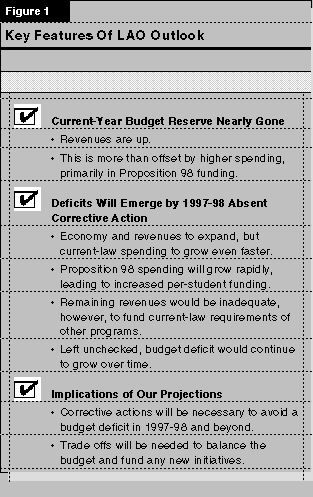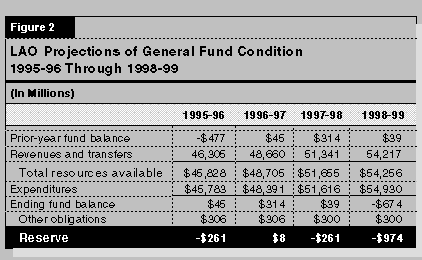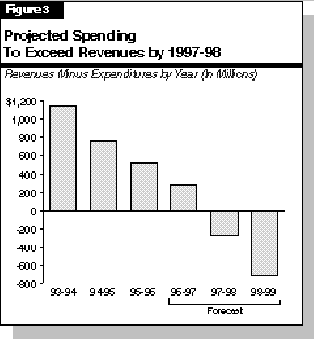
 |
California's Fiscal Outlook |
Over the past three years, California's fiscal condition has improved markedly, with the General Fund moving from a significant deficit position into rough fiscal balance. Our projections for 1996-97 through 1998-99 indicate, however, that budget shortfalls will reemerge, absent corrective action. Figure 1 summarizes our key findings.

For 1996-97, we estimate the state will end the current year with virtually no reserve. This is down from the 1996-97 Budget Act reserve estimate of $305 million. The planned budgetary reserve has been nearly eliminated by higher costs, primarily in Proposition 98.
For 1997-98 and 1998-99, current-law spending requirements will grow faster than revenues, leading to a budget deficit in 1997-98 that will grow thereafter, reaching nearly $1 billion by 1998-99. Constitutionally required Proposition 98 spending will increase fairly rapidly, causing significant pressures on the non-Proposition 98 share of the budget. Our projection of the General Fund condition is summarized in Figure 2.

Our forecast beyond 1996-97 assumes that these positive economic and revenue trends will continue, and that California's economy and state General Fund revenues will continue to grow at moderate rates through 1998-99. Specifically, we project that state revenues will increase by an annual average rate of 5.4 percent between 1995-96 and 1998-99.
It is important to note that our fiscal estimates are not predictions of what the Legislature and Governor will eventually adopt as policies and funding levels in coming budgets. Nor are they our recommendations as to what spending and tax policies should be. Rather, our estimates are a "baseline" projection of what would happen if current policies were allowed to run their course. We believe that by using this approach, our projections provide a meaningful starting point for the Legislature's evaluation of the state's fiscal condition, and its assessment of any necessary future changes to California's spending and taxing levels.
Future Budgets Face Deficits. We project that expenditure growth will exceed revenue growth during the next three years. As Figure 3 shows, this will result in a declining operating surplus (that is, the excess of revenues over expenditures in a given year) in 1996-97 and increasingly large operating deficits thereafter. These operating deficits will emerge despite relatively good economic and revenue performance. During these years, revenues are projected to grow approximately in line with statewide personal income, while the overall gain in expenditures reflects divergent trends among the state's major program areas.

Faster-growing expenditure areas are led by K-14 education, which we project will increase by an average of slightly over 9 percent per year (reflecting particularly rapid growth in 1996-97). Programs experiencing slow or no growth include AFDC, Medi-Cal, and SSI/SSP, reflecting small or no growth in caseloads and projected increases in federal funds, partly resulting from federal welfare reform legislation.
As indicated above, our estimates assume the restoration of the renters' credit and certain welfare grant reductions and cost-of-living adjustments in 1997, as required by current law. These restorations are projected to result in about $775 million of additional state expenditures beginning in 1997-98.
Proposition 98 funding will take a growing share of the budget over this period, resulting in increasing pressures on the non-Proposition 98 portion of the budget. As noted above, there will be insufficient money to fully fund all of these programs and balance the budget. In addition, it should be noted that our projections assume no new spending initiatives in the non-Proposition 98 portion of the budget. Inclusion of new or expanded programs would add to the trade-offs the Legislature will face in developing its spending plans in 1997-98 and 1998-99. For example, with regard to implementation of federal welfare reform, our estimates imply that increases in funding for welfare-to-work programs, or other initiatives, would need to be financed from budgetary savings. Any increased funding for local governments or tax reductions would have to be financed similarly.
Lastly, it is important to emphasize that our projections are predicated on continued moderate economic growth, with no significant economic slowdown or recession in the next few years, and also embody various assumptions regarding program costs and federal funds. Our projections
imply, however, the state would have no meaningful reserve to cushion against unanticipated cost increases or shortfalls in revenues or federal funds.